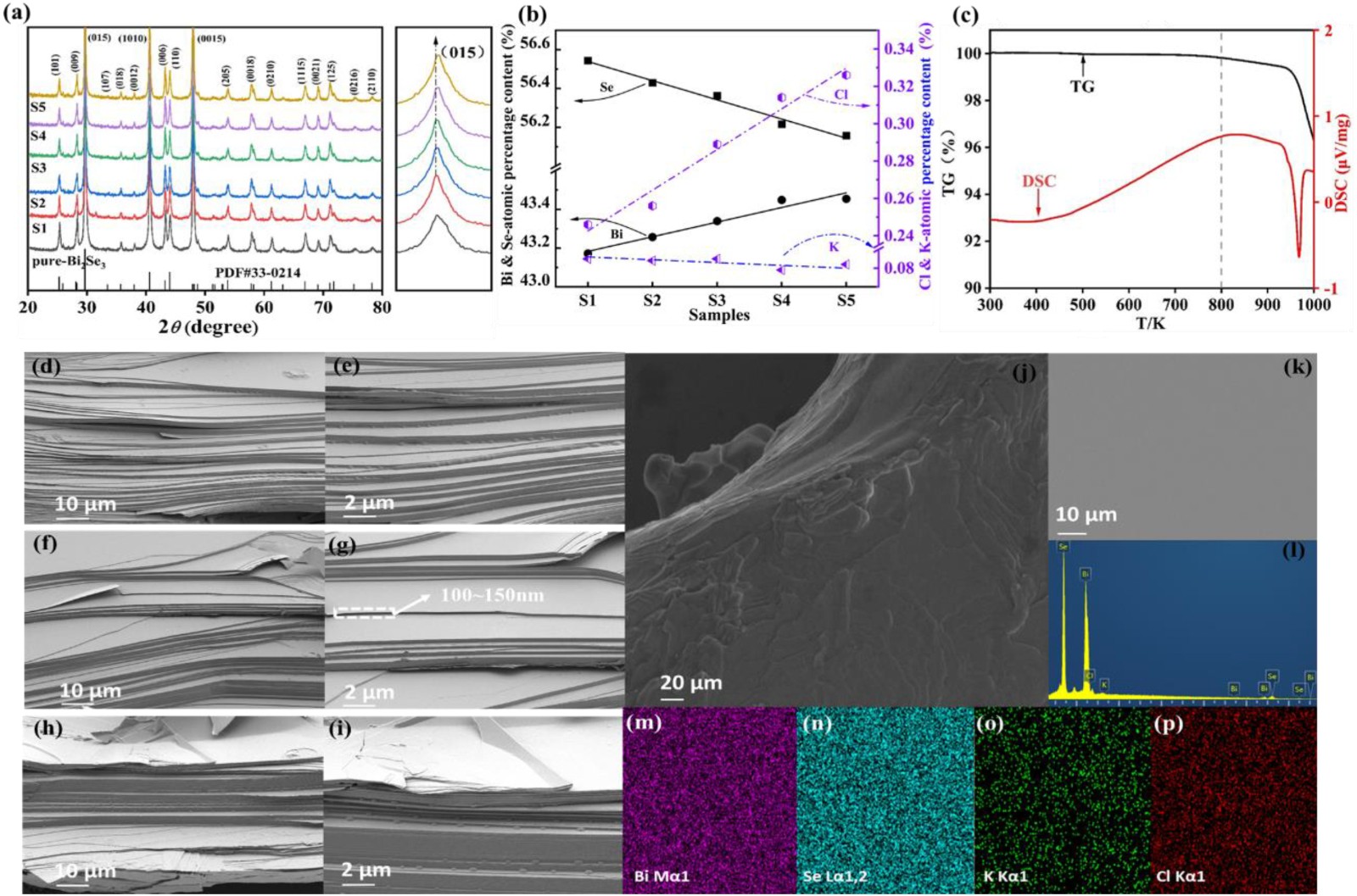博文
云师大邓书康在硅酸盐top期刊《Ceramics International》发表最新研究成果
||
云师大邓书康在硅酸盐top期刊《Ceramics International》发表题为《Ultra-low lattice thermal conductivity and high figure-of -merit in Cl and K co-dopped Bi2Se3 prepared by KCl flux 》的最新研究成果。


Ultra-low lattice thermal conductivity and high figure-of -merit in Cl and K co-dopped Bi2Se3 prepared by KCl flux
Yaohui Liu, Yu Tang, Lanxian Shen, Wen Ge, Peizhi Yang, Shukang Deng
Education Ministry Key Laboratory of Renewable Energy Advanced Materials and Manufacturing Technology, Yunnan Normal University, Kunming, 650500, China
Received 16 March 2023, Revised 17 May 2023, Accepted 26 May 2023, Available online 10 June 2023.
Handling Editor: P. Vincenzini
https://doi.org/10.1016/j.ceramint.2023.05.248Get rights and content
Abstract
Bismuth telluride (Bi2Te3) is a widely used thermoelectric (TE) material in practical applications. However, it contains expensive and toxic tellurium, a promising TE material should include low-cost and non-toxic element. Bismuth selenide (Bi2Se3) is similar to Bi2Te3 in electronic and crystal structure. The electron effective mass of Bi2Se3 is smaller than that of Bi2Te3, while its electrical transport performance is inferior to that of Bi2Te3. Therefore, in this study, Cl and K co-doped Bi2Se3 thermoelectric material with high density, low thermal conductivity, and excellent thermoelectric performance was prepared using KCl as the solvent. It is found that the effective electron mass and carrier concentration of the doped sample is effectively improved, which significantly increases the doped sample's electrical transport properties and ZT value. Finally, the Bi2Se3(KCl)3.5 sample reached a maximum ZT value of 0.79 at 550 K, and the average ZT in the measured temperature range reached 0.45.
Introduction
Thermoelectric (TE) material is a type of functional material that can realize the direct conversion between thermal and electric energy. TE materials are used in TE power generation and electric refrigeration [[1], [2], [3]]. They are mainly used in deep space detectors, space detectors, industrial waste heat recovery and utilization, solar efficient photothermal–thermoelectric composite power generation, and so on [4,5]. The efficiency of thermoelectric power generation is mainly determined by the dimensionless figure of merit ZT () of materials [[6], [7], [8]]. A promising semiconductor material must have a large Seebeck coefficient S, high electrical conductivity σ, and low thermal conductivity κ at a certain temperature T [[9], [10], [11], [12]]. Seebeck coefficient and conductivity can be obtained from the following formula:where n is the carrier concentration, m* denotes the carrier effective mass, h represents the Planck constant, kB is the Boltz constant, μ refers to carrier mobility, e stands for the unit charge, and is the relaxation time [[13], [14], [15]]. Therefore, reducing the carrier concentration can increase the Seebeck coefficient, but it can reduce the electrical conductivity of the material [[16], [17], [18]]. Similarly, higher carrier concentration can greatly improves the electrical conductivity of the material, but at the same time, it reduces the Seebeck coefficient of the material [[19], [20], [21]]. Therefore, the effective mass and carrier concentration should be well optimized in order to obtained high-performance thermoelectric materials [22].
Bi2Se3 is a layered chalcogenide with a hexahedron structure and group space of R-3m. The crystal structure is composed of Bi atom and Se atom in the form of Se(1)-Bi-Se(2)-Bi-Se-Se(2)-Bi-Se(1), in the layered units, five atoms stacked along the crystallographic of c-axis and repeatedly arranged; The same kind of atoms occupy the same layer. Bi atoms form a two-dimensional planar hexagonal structure in Bi layer. There are two different types of Se(1) and Se(2) in Se layer. Se(1)-Se(1)layers are connected by Van der Waals force, Bi-Se(1) is combined by covalent bond and ionic bond, Bi-Se(2) is covalent bond, and Se atoms in Se (2) layer are surrounded by octahedron composed of Bi atoms. The thickness of the penta-atomic layer is about 1 nm. This natural nanostructure greatly reduces the lattice thermal conductivity of the material and is expected to result in higher TE performance. Compared with Bi2Te3 TE material, Bi2Se3 has the same crystal and energy band structure except for a larger band gap. Compared with rare and expensive Te, the Se has a rich storage capacity in earth. Therefore, the TE material of Bi2Se3 at a medium temperature has wider application than Bi2Te3 [[23], [24], [25]].
As a potential thermoelectric material, however, the TE performance of Bi2Se3 is relatively low due to its low carrier concentration. In order to further improve the electrical transport properties, in this work, Cl and K-doped Bi2Se3 thermoelectric materials were prepared by a high-temperature melting method in KCl solvent, and its structure and thermoelectric properties were studied deeply. The results show that the carrier concentration and mobility of doped Bi2Se3 are effectively improved, the maximum PF value of 13.7 mW cm−1·K−2 is obtained in the Bi2Se3 (KCl)3.5 sample at 500 K. The TEM detection results of Bi2Se3 (KCl)3.5 show that a large number of crystal defects, such as dislocations and distortions exist in the sample, which will enhance the scattering of phonons so that the lattice thermal conductivity of the sample is significantly reduced compared with the intrinsic sample. Finally, the maximum ZTvalue of 0.79 was obtained at 550 K.
https://blog.sciencenet.cn/blog-454141-1391664.html
上一篇:云师大王洪恩教授在《Journal of Materials Chemistry A》上发表最新研究成果
下一篇:云师大2023年1-6月CSSCI收录论文一览表,欢迎参考和引用
1 张伟斌
该博文允许注册用户评论 请点击登录 评论 (0 个评论)

-
鍥炲
|
 璧�
+1
[4]wqhwqh333
璧�
+1
[4]wqhwqh333
- 鍦ㄥ垰寮€濮嬪仛鐮旂┒鐨勯偅鍑犲勾锛屾垜鐢氳嚦涓嶇煡閬撶粏鑳炲懆鏈熸槸浠€涔堬紒
*************************************
杩欎綅澶у笀鐨勫熀纭€澶樊浜嗭紝浠栨槸鐮旂┒缁嗚優鍛ㄦ湡鐨勶紝鍗磋繛缁嗚優鍛ㄦ湡鐨勬蹇甸兘涓嶇煡閬撱€備絾鏄熀纭€涓嶆槸鏈€涓昏鐨勶紝鏈€涓昏鐨勬槸鍏磋叮鍜屽ソ濂囧績锛佹湁浜嗗叴瓒e拰濂藉蹇冿紝浼氬緢蹇涔犺繖浜涙蹇碉紝寮ヨˉ杩欎簺涓嶈冻銆備絾娌℃湁鍏磋叮鍜屽ソ濂囧績锛岀‘瀹炴棤娉曞讥琛ョ殑銆傛垜鍥界殑绉戠爺鐣岄潪甯稿己璋冨熀纭€锛屽己璋冮敊璇簡锛岃蛋鍒版璺笂鍘讳簡銆�

-
鍥炲
|
 璧�
+1
[3]鍒橀椈閾�
璧�
+1
[3]鍒橀椈閾�
- 鎴戣闂垜鍥戒竴浣嶉厭鐨勪笓瀹讹紝浠栬锛屼粬鍋氶厭鐨勫垎鏋愶紝鍑犱箮蹇樿鍏虫満鍣紝寰堥暱鏃堕棿鍑烘潵涓€涓緢楂樼殑鈥滄煴瀛愨€�------杩欏氨鏄喅瀹氳寘鍙伴鍛崇殑鍏抽敭鎴愬垎銆�

-
鍥炲
|
 璧�
+1
[1]loyalSciencefan
璧�
+1
[1]loyalSciencefan
- 涓€璺笂锛屾垜杩樺彂鐜帮紝褰撲綘鐨勭粨鏋滀細鎸戞垬宸茬粡寤虹珛鎴栬澶у鎺ュ彈鐨勭爺绌讹紝浣犱細浠庤澶氫汉閭h竟閬亣鏇磋壈闅剧殑鎯呭喌锛屽寘鎷湡鍒婂绋夸汉銆傝繖灏辨槸涓轰粈涔堜綘涓€瀹氳瀹屽叏纭俊浣犵殑缁撴灉锛屽嵆浣胯繖琛ㄧず浣犺鍋氳嚜宸辨渶涓ュ帀鐨勬壒璇勮€咃紝浣嗘€绘瘮璁╁埆浜鸿川鐤戜綘鎴栬€呮敾鍑讳綘鐨勫伐浣滄潵寰楀ソ銆�
==============
姝よ瘽璇村緱澶氫箞鐨勬湸瀹炪€佽瘹鎭炽€佸涔堢殑瀹炲湪鎺ュ湴姘斻€� 涓€璇亾鍑轰簡鐪熺鐮旂殑鐪熻皼锛侊紒锛�
涓€璇亾鍑轰簡鐪熺鐮旂殑鐪熻皼锛侊紒锛�
1/1 | 鎬昏:5 | 棣栭〉 | 涓婁竴椤� | 涓嬩竴椤� | 鏈〉 | 璺宠浆 |
